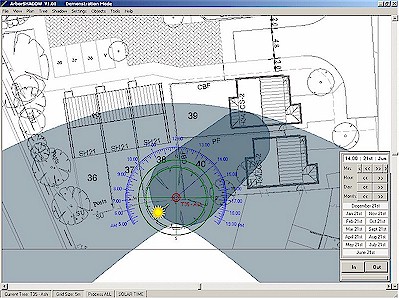History
After exploring the whole concept of tree shadows and becoming frustrated at the current tools available to calculate them I decided to create something which make life easier in my work. The main requirements behind the program was to plot the shadows graphically onto a site plan so an immediate assessment could be made visually. At this stage any thoughts of making the program available to others was not on the agenda.
Work on the shadow program actually started around 2002 and proceeded slowly until early 2005, with many lengthy gaps in between programming sessions due to work or other more interesting activities! On a few occasions the whole idea was nearly 'ditched' due to difficulties in development and other external pressures. However, a solution always appeared when most needed and at times I wondered whether the program had its own will to succeed!
It was mid 2003 before a usable program was actually ready (see following). This was called 'TreeTrace' and plotted a tree with a single canopy dimension and a choice of crown shapes. The individual tree shadow is shown outlined in black with the extents of the 'day shadow' shown as a single red line with hour markings. An option to export straight to AutoCAD was included in the initial design.
Work on the shadow program actually started around 2002 and proceeded slowly until early 2005, with many lengthy gaps in between programming sessions due to work or other more interesting activities! On a few occasions the whole idea was nearly 'ditched' due to difficulties in development and other external pressures. However, a solution always appeared when most needed and at times I wondered whether the program had its own will to succeed!
It was mid 2003 before a usable program was actually ready (see following). This was called 'TreeTrace' and plotted a tree with a single canopy dimension and a choice of crown shapes. The individual tree shadow is shown outlined in black with the extents of the 'day shadow' shown as a single red line with hour markings. An option to export straight to AutoCAD was included in the initial design.
The next version (early 2004) used the traditional north, south, east & west crown dimension settings (note the offset crown shape). The 'day shadow' has become advanced in an attempt to show more of the area. This version was used to support a shadow assessment in an AIS report. The program name reads 'Tree Shadow Workshop' and plans were made at this stage to make it available to others. The AutoCAD option was dropped.
Winter 2004, and the program had evolved further into something I was nearly happy with....but not quite. The upper crown size definition was in place and a more accurate representation of the trees shadow implemented. The Local Time option and Analyser function had been included at this time.
But along came the .NET framework programming environment which offered better graphic options and a number of solutions to many pending bugs. So, I decided to go for a complete rewrite during January 2005. Such a fresh start has any advantages especially in program design where you can encompass all modifications which had been 'bolted on' and which could make future upgrades and debugging a nightmare. A new, more accurate method of shade projection was devised and the idea of shading introduced. After a brief pause during early 2005, while ArborCAD was created, the program was finished in May 2005.
And finally in 2014 work started on the R4 of the software which uses the AxciScape interface as a base. The main requirement was to be able to handle any number of trees and target areas without slowing the map generation down to a crawl. It also had to offer AutoCAD export and compatibility with earlier versions of ArborShadow.
It proved to be a challenge and was nearly abandoned on several occasions. In fact it took the best part of 2 years to complete as it had to compete for time with other much more interesting and attractive 'projects' and of course work!
It proved to be a challenge and was nearly abandoned on several occasions. In fact it took the best part of 2 years to complete as it had to compete for time with other much more interesting and attractive 'projects' and of course work!






